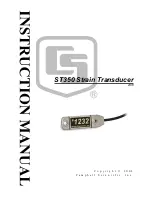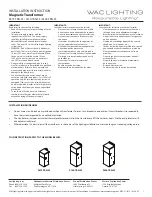
65-2405RK-04 Combustible Gas Transmitter • 11
6.
Turn the regulator’s on/off knob counterclockwise to open it. Gas will begin to flow.
7.
Allow the gas to flow for the length of time determined in “Determining Response
Time” on page 16.
8.
Verify a voltmeter reading of 100 mV (±2 mV).
9.
If necessary, use a small flat-blade screwdriver to adjust the zero pot until the
voltmeter reading is 100 mV (±2 mV).
10. Turn the regulator’s on/off knob clockwise to close it.
11. Disconnect the calibration cup/splash guard’s flexible tubing from the regulator.
NOTE:
Do not disconnect the flexible tubing from the calibration cup/splash guard.
12. Unscrew the regulator from the zero air calibration cylinder.
13. Store the components of the calibration kit in a safe and convenient place.
14. Remove the voltmeter leads from the test points.
15. Secure the junction box cover to the junction box.
Maintenance
This section describes maintenance procedures. It includes preventive maintenance,
troubleshooting, and component replacement procedures.
Preventive Maintenance
This section describes a preventive maintenance schedule to ensure the optimum
performance of the combustible gas transmitter. It includes daily, monthly, and quarterly
procedures.
Daily
Verify a display reading of 0 %LEL at the controller. Investigate significant changes in the
display reading.
Monthly
This procedure describes a test to verify that the combustible gas transmitter responds
properly to the target gas.
WARNING: The controller is not an active gas monitoring device during the response
test procedure.
NOTE:
Performing a response test on the combustible gas transmitter may cause alarms.
Be sure to put the controller into its calibration mode or disable external alarms
before performing this test.
NOTE:
The following procedure assumes the use of a calibration kit which includes a
calibration gas cylinder, a 0.5 LPM fixed flow regulator with an on/off knob, a
calibration cup for the detector, and a length of sample tubing.
www.
.com
1.800.561.8187









































